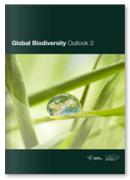10 May 2010: The third edition of Global Biodiversity Outlook (GBO-3), a major assessment of the current state of biodiversity and the implications of its continued loss for human well-being, has been launched.
The report notes that the linked challenges of biodiversity loss and climate change must be addressed with equal priority and in close […]
 10 May 2010: The third edition of Global Biodiversity Outlook (GBO-3), a major assessment of the current state of biodiversity and the implications of its continued loss for human well-being, has been launched. The report notes that the linked challenges of biodiversity loss and climate change must be addressed with equal priority and in close coordination, if the most severe impacts of each are to be avoided.
10 May 2010: The third edition of Global Biodiversity Outlook (GBO-3), a major assessment of the current state of biodiversity and the implications of its continued loss for human well-being, has been launched. The report notes that the linked challenges of biodiversity loss and climate change must be addressed with equal priority and in close coordination, if the most severe impacts of each are to be avoided.
The product of close collaboration between the Secretariat of the Convention on Biological Diversity (CBD) and the UN Environment Programme’s World Conservation Monitoring Centre (UNEP-WCMC), GBO-3 confirms that the world has failed to meet its target to achieve a significant reduction in the rate of biodiversity loss by 2010. Climate change is among the five principal pressures directly driving biodiversity loss. At the same time, it is recognized that opportunities exist to address the biodiversity crisis while contributing to other social objectives, including the fight against climate change. Analyses identify scenarios in which climate change is mitigated while maintaining and even expanding the current extent of forests and other natural ecosystems, and avoiding additional habitat loss from the widespread deployment of biofuels.
The report concludes that the linked challenges of biodiversity loss and climate change must be addressed by policy makers with equal priority and in close coordination if the most severe impacts of each are to be avoided. Reducing the further loss of carbon-storing ecosystems such as tropical forests, salt marshes and peatlands will be a crucial step in limiting the build-up of greenhouse gases (GHG) in the atmosphere. At the same time, reducing other pressures on ecosystems can increase their resilience, make them less vulnerable to those impacts of climate change that are already unavoidable, and allow them to continue to provide services to support people’s livelihoods and help them adapt to climate change.
The report outlines a possible new strategy for reducing biodiversity loss, including addressing the underlying causes of its indirect drivers, such as patterns of consumption, the impacts of increased trade and demographic change, and ending harmful subsidies. It is based on: an analysis of the current status and trends of biodiversity carried out by the Biodiversity Indicators Partnership; a study of future scenarios and models involving a wide range of scientists from the Diversitas network and UNEP-WCMC; the review of hundreds of scientific articles and assessments; and national reports submitted by CBD parties. Subject to an extensive independent scientific review process, it is one of the milestones of 2010 International Year of Biodiversity. [GBO-3 Website][CBD Press Release][GBO-3 Main Findings]